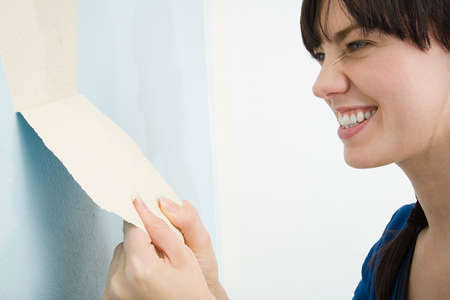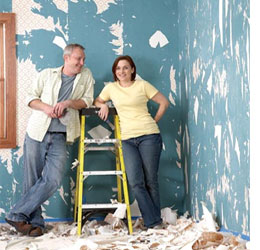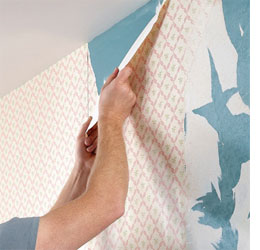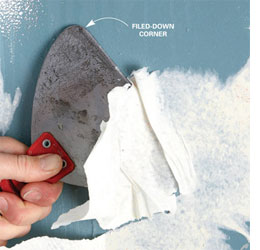Removing wallpaper
Removing wallpaper is an ugly job. We can't make it pretty, but we can make it easier.
I’m not going to sugarcoat it. Removing wallpaper is a messy, time-consuming and tedious job. I wish I could tell you there’s a nifty new product that will make the whole thing easy. But there isn’t. And if you don’t know what you’re doing or you start to get frustrated, you can damage your walls or stop before the job is done.
The tips in this article won’t make the job fun. But they will help you do it more efficiently, without damaging your walls. They’ll also show you how to get a wall perfectly clean, ready for a fresh coat of paint or new wallpaper.
Do yourself a favour and take a full weekend to do the job right. Attack the messy and hard stuff on day one and use the second day to prep the walls for paint or new wallpaper.
Tape plastic to the skirting board, allowing it to overlap the floor about half a metre. Press hard on the tape to create a watertight seal. Cover the draped plastic with more plastic and top that with towels to absorb the water as it runs down the walls. Everything is going to get wet and sticky, so carefully protect the floor, furniture and woodwork.
Take everything off the walls, including vents, outlet covers and switch plates, and mask the openings with plastic and tape. Turn off the electricity to the room at the main panel and use high-quality work lamps on extension cords to light your work area. If possible, remove the furniture completely. If not, move it to the centre of the room and cover it with plastic.
Use a putty knife to get the edge of the paper started, if necessary, and pull the paper back slowly at a 45-degree angle, applying moderate pressure. You can sometimes pull down entire sheets of newer wallpapers with this technique. But the longer the paper has been up, the more likely it is to come off in smaller pieces (or not at all). If you just can’t remove the facing at all, use a scoring tool before moving on to the next step.
Apply hot water to the remaining wallpaper using a sponge or floor mop. This lets you control the amount of water you're applying each time. Let the wallpaper absorb the water for up to 15 minutes. You may have to apply water several times to soften the paste.
Apply the hottest water you can tolerate (wear gloves!) to the wallpaper to soften it and the adhesive underneath. The hard part is doing this without damaging the wall surface. Plaster walls can take a lot of hot water without a problem. Apply the water using a sponge (or a floor mop for the high spots).
Let the wallpaper absorb the water until it starts to pull away from the wall. When it softens (use your fingernail or a scraper to check), you’re ready for the next step.
Use an old, very flexible metal spatula or putty knife with rounded corners to scrape the backing and remaining facing off the wall. Don't use the spatula too aggressively — the wall might be soft in spots and scraping too hard can easily gouge it. Using a flexible blade is key because it won't dig into the wall as much. Plastic spatulas or scrapers don't work—they're too thick to get underneath the backing. OK.
This is the moment when most people give up. You’re tired, the wall looks clean and you just want to be done. So the temptation is to call it a (very long) night and “not see” the paste that’s still there. Paste has a dark sheen to it and the wall will still feel sticky. Spray a light mist of water on the “clean” wall.
Hold your work light parallel to the wall and you’ll see the paste that remains. If you don’t get it all off, when you paint the wall, the paint will eventually flake and crackle. Wallpaper that’s applied over it will bubble or fail to stick properly.
Use Genkem Wallpaper Stripper to dissolve wallpaper adhesives. You won’t need a whole lot, so it’s not going to break the bank. You can scrape off the any paste with minimal cleanup. After the paste is completely gone, rinse the wall with water until it’s smooth and squeaky clean. Now go to bed.
The next day after the wall has dried thoroughly (and you’ve had a good night’s sleep), prep the wall for paint or new wallpaper. Patch large gouges or holes from the scoring tools with interior crack filler. Once your repairs are dry, sand the wall until it’s smooth.
the family handyman






